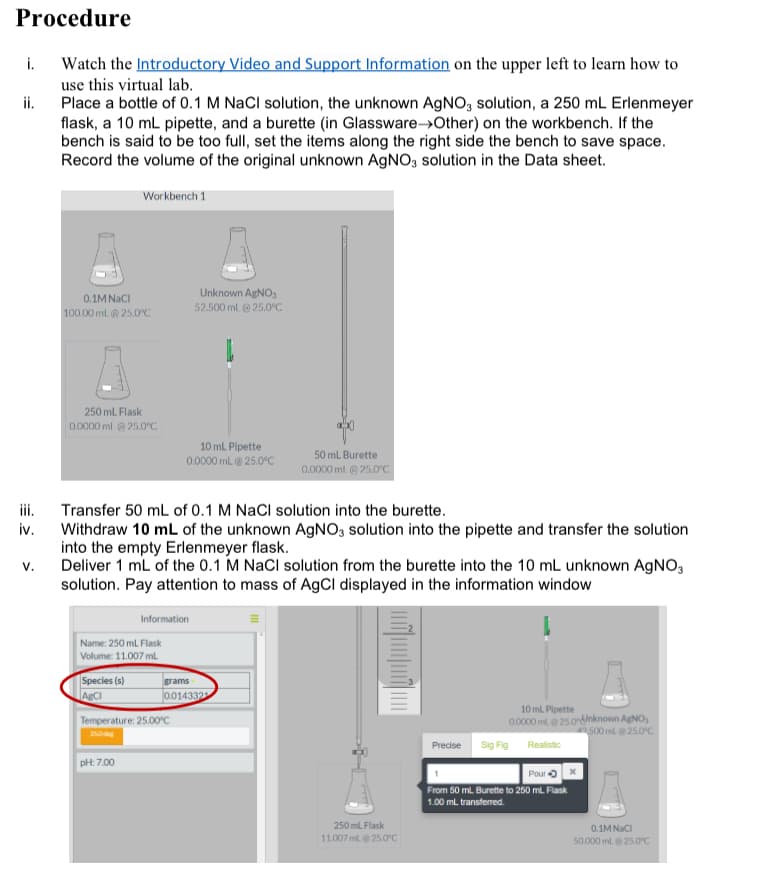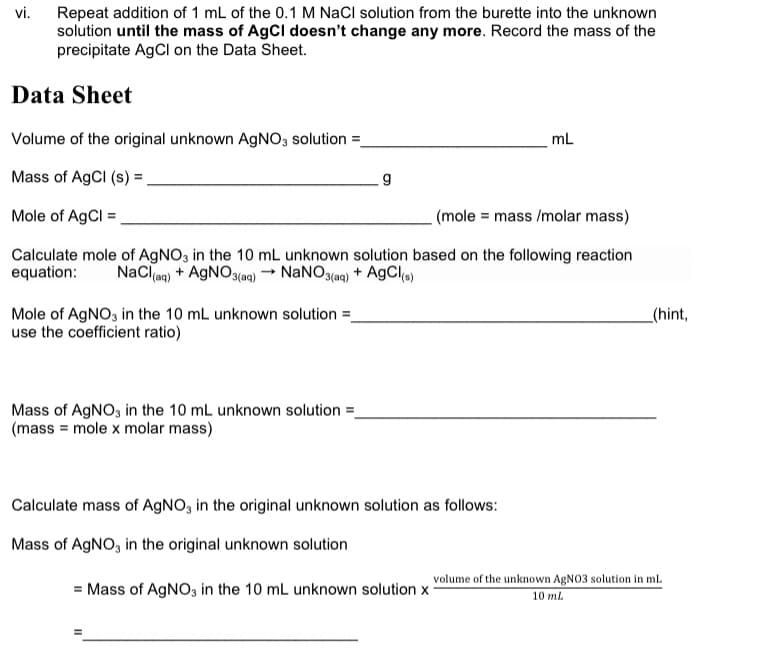use this virtual lab. i. Place a bottle of 0.1 M NaCl solution, the unknown AgNO, solution, a 250 mL Erlenmeyer flask, a 10 mL pipette, and a burette (in Glassware-→Other) on the workbench. If the bench is said to be too full, set the items along the right side the bench to save space. Record the volume of the original unknown AGNO, solution in the Data sheet. Workbench 1
use this virtual lab. i. Place a bottle of 0.1 M NaCl solution, the unknown AgNO, solution, a 250 mL Erlenmeyer flask, a 10 mL pipette, and a burette (in Glassware-→Other) on the workbench. If the bench is said to be too full, set the items along the right side the bench to save space. Record the volume of the original unknown AGNO, solution in the Data sheet. Workbench 1
Chemistry
10th Edition
ISBN:9781305957404
Author:Steven S. Zumdahl, Susan A. Zumdahl, Donald J. DeCoste
Publisher:Steven S. Zumdahl, Susan A. Zumdahl, Donald J. DeCoste
Chapter1: Chemical Foundations
Section: Chapter Questions
Problem 1RQ: Define and explain the differences between the following terms. a. law and theory b. theory and...
Related questions
Question

Transcribed Image Text:Procedure
i.
Watch the Introductory Video and Support Information on the upper left to learn how to
use this virtual lab.
ii.
Place a bottle of 0.1 M NaCl solution, the unknown AgNO, solution, a 250 mL Erlenmeyer
flask, a 10 mL pipette, and a burette (in Glassware>Other) on the workbench. If the
bench is said to be too full, set the items along the right side the bench to save space.
Record the volume of the original unknown AGNO, solution in the Data sheet.
Workbench 1
Unknown AgNO
52.500 ml. @ 25.0°C
0.1M NaCI
100.00 ml. @ 25.0°C
250 mL Flask
0.0000 ml @ 25.0C
10 ml. Pipette
0.0000 mL @ 25.0°C
50 mL. Burette
0.0000 ml. @ 25.0C
ii.
Withdraw 10 mL of the unknown AgNO3 solution into the pipette and transfer the solution
into the empty Erlenmeyer flask.
Deliver 1 mL of the 0.1 M NaCl solution from the burette into the 10 mL unknown AGNO,
solution. Pay attention to mass of AgCI displayed in the information window
Transfer 50 mL of 0.1 M NaCl solution into the burette.
iv.
V.
Information
Name: 250 mL Flask
Volume: 11.007 ml
Species (s)
ABCI
grams
J0014332
10 ml Pipette
0000 mle 25.0rdnknown AgNO,
n s00 ml e 25.0°C
Temperature: 25.00°C
250dg
Sig Fig Realistic
Precise
pt: 7.00
Pour o
From 50 ml. Burette to 250 mL Flask
1.00 mL transferred.
250 mL Flask
0.1M NaCI
11.007 ml@ 25.0°C
50.000 ml.@ 25.0°C

Transcribed Image Text:vi.
Repeat addition of 1 mL of the 0.1 M NaCl solution from the burette into the unknown
solution until the mass of AgCl doesn't change any more. Record the mass of the
precipitate AgCl on the Data Sheet.
Data Sheet
Volume of the original unknown AGNO3 solution =
mL
Mass of AgCl (s) =,
Mole of AgCl =
(mole = mass /molar mass)
Calculate mole of AGNO3 in the 10 mL unknown solution based on the following reaction
equation:
NaCliag) + AGNO3(aq) → NANO3(aq) + AgCls)
Mole of AGNO, in the 10 mL unknown solution =
use the coefficient ratio)
_(hint,
Mass of AGNO3 in the 10 mL unknown solution =
(mass = mole x molar mass)
Calculate mass of AGNO, in the original unknown solution as follows:
Mass of AGNO, in the original unknown solution
= Mass of AGNO, in the 10 mL unknown solution x
volume of the unknown AGNO3 solution in ml.
10 ml
Expert Solution
This question has been solved!
Explore an expertly crafted, step-by-step solution for a thorough understanding of key concepts.
This is a popular solution!
Trending now
This is a popular solution!
Step by step
Solved in 3 steps with 3 images

Knowledge Booster
Learn more about
Need a deep-dive on the concept behind this application? Look no further. Learn more about this topic, chemistry and related others by exploring similar questions and additional content below.Recommended textbooks for you

Chemistry
Chemistry
ISBN:
9781305957404
Author:
Steven S. Zumdahl, Susan A. Zumdahl, Donald J. DeCoste
Publisher:
Cengage Learning

Chemistry
Chemistry
ISBN:
9781259911156
Author:
Raymond Chang Dr., Jason Overby Professor
Publisher:
McGraw-Hill Education

Principles of Instrumental Analysis
Chemistry
ISBN:
9781305577213
Author:
Douglas A. Skoog, F. James Holler, Stanley R. Crouch
Publisher:
Cengage Learning

Chemistry
Chemistry
ISBN:
9781305957404
Author:
Steven S. Zumdahl, Susan A. Zumdahl, Donald J. DeCoste
Publisher:
Cengage Learning

Chemistry
Chemistry
ISBN:
9781259911156
Author:
Raymond Chang Dr., Jason Overby Professor
Publisher:
McGraw-Hill Education

Principles of Instrumental Analysis
Chemistry
ISBN:
9781305577213
Author:
Douglas A. Skoog, F. James Holler, Stanley R. Crouch
Publisher:
Cengage Learning

Organic Chemistry
Chemistry
ISBN:
9780078021558
Author:
Janice Gorzynski Smith Dr.
Publisher:
McGraw-Hill Education

Chemistry: Principles and Reactions
Chemistry
ISBN:
9781305079373
Author:
William L. Masterton, Cecile N. Hurley
Publisher:
Cengage Learning

Elementary Principles of Chemical Processes, Bind…
Chemistry
ISBN:
9781118431221
Author:
Richard M. Felder, Ronald W. Rousseau, Lisa G. Bullard
Publisher:
WILEY